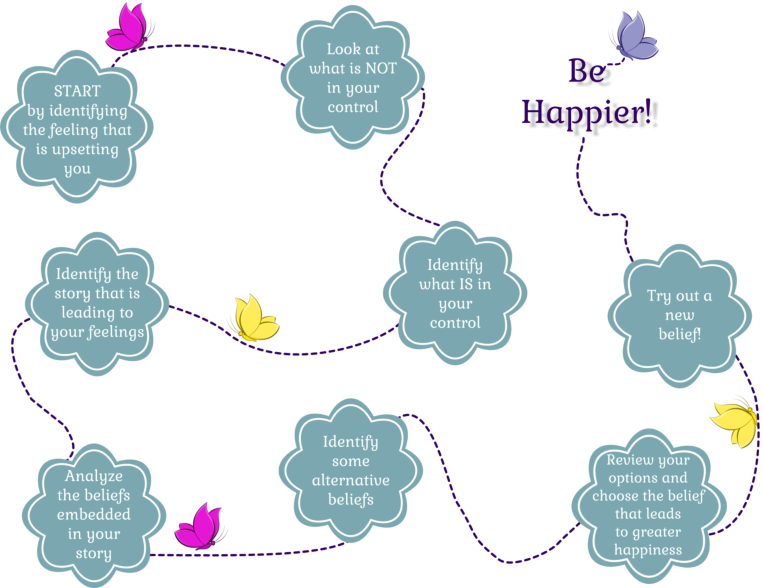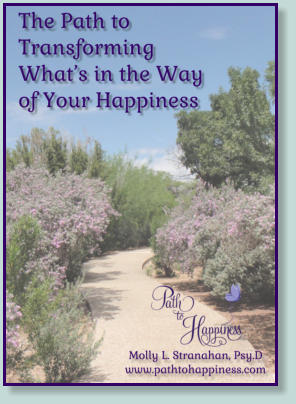

TRANSFORM WHAT’S IN THE WAY OF YOUR HAPPINESS
You came to this page because something is in the way of your happiness – probably an uncomfortable feeling, a situation, a person. The 8 Step Guide to Transforming Your Feelings illustrates a process for removing that block to your happiness. The steps below focus on changing your story – your beliefs about what is happening. The steps beneath the diagram include another tool at your disposal - uncovering more options for how you can behave. Our beliefs often limit our happiness by preventing us from fully considering all of the action options available to us.8 STEP GUIDE TO TRANSFORMING YOUR FEELINGS
Step One: Pay attention to the message of your feelings, especially when
you’re upset
Notice whether you are comfortable or stressed, happy or unhappy. Try to get to basic feelings (happy, hurt, angry, afraid, anxious, sad, lonely, guilty, ashamed). Feelings are messages. They are a result of what happens to you AND what you tell yourself based on your beliefs about the world. Not everyone will react to the same situation with the same feelings. Your feelings are a result of the story you tell yourself about what is happening to you. This process can help you identify the story that is upsetting you. Unpleasant feelings give you the opportunity to look at changing something in your life – your story, your behavior or your expectations.Step Two: Look at what is NOT in your control
Remember that you do not control OTHER PEOPLE’s behavior and feelings or for that matter, their perceptions or beliefs. So accept others as they are, and let go of the desire to make them what you want them to be. You can tell them what you would like, and the consequences you will offer for their behavior, but they decide what they will do. You also cannot change the PAST. It is past, it has happened. You can change how you feel about it, and what you believe about it. You can share your experience of it with others. But you can’t change what happened. You can let go of the hold it has on you. Free yourself of worry about the FUTURE. We worry about things that might happen over which we have little or no control. Examples are the stock market, terrorist attacks, death. When there are things we can do to protect ourselves, we should do them, then let go of the worry. If you have done what you can, the rest is out of your control so don’t let worry control your happiness. Trust that you will be able to cope with the future when it makes itself known.Step Three: Identify what IS in your control
You control YOUR BEHAVIOR. You are responsible for how you respond to the events in your life - how you treat yourself and other people. DECIDE whether or not to stay in the situation. Often we forget that we can end a relationship, give up a job, or get out of a long line. Sometimes we get mad about a situation that feels out of our control, and don’t recognize we have a choice. COMMUNICATE what you are feeling and what you would like. Many times others don’t know you are bothered by something. It wouldn’t bother them, or they didn’t notice. It is up to you to share your reactions. Determine the CONSEQUENCES YOU SET FOR OTHER PEOPLE’S BEHAVIOR. This is the only way to successfully influence someone else’s behavior. For the abused spouse, she can tell her husband that unless he starts anger management classes by a week from Friday, she will leave. And if he ever harms her again, she will be gone. This can include setting up bargains so both parties can be happy. For instance, you might offer to give a ten-minute back rub in exchange for being taken out for dinner. Just like in raising children, you must follow through on the consequences or bargains, so think seriously before you declare a consequence. Examine YOUR BELIEFS. This one is so important it has its own steps below.Step Four: Identify the STORY that is leading to your feelings – and the
beliefs that underlie the story
Why are you feeling this (e.g. Why am I unhappy with my job)? I believe that _________ (e.g., a job should be fun and psychologically rewarding. I should feel challenged and energized by my work.) It can help to ask yourself “What would someone experiencing this feeling when X happens be thinking or believing? What story would someone else need to have to feel the way I am feeling in this circumstance?”Step Five: ANALYZE THE BELIEF embedded in your story
Ask yourself if it is true. Is it true for everyone in the world? Can it be tested? Look for evidence to confirm or contradict your belief. Look for patterns in the ways you tend to interpret situations – the beliefs through which you filter your experiences (e.g. no one respects me). Look for shoulds, woulds, coulds, have tos, and judgments (right, wrong, good, bad, stupid). Look for expectations, assumptions, catastrophic thinking and over- generalizations. Is it a wish for how you would like the world to be? Is it just your preference?Step Six: Identify some ALTERNATIVE beliefs
Is there another belief that might lead you to have a different feeling in this situation? Imagine what story or belief someone who feels calm or happy in the circumstances you are experiencing would have. You can ask other people for ideas of different ways to interpret your situation.Step Seven: Review your OPTIONS and choose the belief that
leads to feeling happier
ANALYZE the potential new story and the story identified in Step Four by asking which belief is most likely to lead to being happier. Choose the belief that leads to the feelings you want to have – feelings of less distress and more happiness. Is there something you can do about the situation (get out, share your feelings, set consequences)? What can you not change in the situation (other people, the past, the future)? Let go of being upset about things that are not in your control. Remember changing your story is ALWAYS an option.Step Eight: TRY OUT THE NEW BELIEF
Ask yourself, “If I believed the new belief, how would I act differently? How would I feel?” If you think you might feel better, tell yourself “Now, I’m choosing to believe …” Sometimes you need to look at what you are afraid would happen if you change your belief. A common fear that people express is “What if my new belief is wrong?” As in, “What if I believe that I am a worthy person, but I am wrong?” Check again if it is a provable thing, or just something that people have beliefs about. If it is provable ask yourself, “What would be the consequences if I am wrong?” But usually, we discover that it would only be a matter of opinion. You can choose to believe in self-fulfilling prophesies, and then choose the belief that you most want to have be true! Take the new story for a test drive. Say to yourself, “I am choosing to believe ….” Write your new story on a sticky note and put it someplace you will see it regularly. Try to live as if you believed it. See how it feels. Does it make you feel better? Remember, it doesn’t have to pass a trueness test; it just has to make you feel better. When you decide what makes you happiest, and most content, keep telling yourself that story. Next time the feeling comes up in a similar situation, try to remember the new belief sooner than the last time.





























Choose to be happier!
You have found the place
to learn what YOU can do
to have a happier,
more fulfilling life!

Learn More
The Path to Transforming What’s in the Way of Your Happiness booklet (PDF) The Path to Happy Relationships The Path to Happy Relationships booklet (PDF)Help for Your Journey
Transforming What’s in the Way (PDF) Identifying Emotions (PDF) Changing Deceptive Brain Messages to New Beliefs (PDF) Letting Go (PDF) Dealing with Fear, “What If…” (PDF) Stop Postponing Happiness, “I Would Be Happy If Only…” (PDF) Transforming Shoulds (PDF) Making Change Happen (PDF)





Transforming What’s In the Way
(PDF) will step you through
applying the process to the issue
that is bothering you. If your
problem is another person, you
might want to try using
Transforming Your Relationships
(PDF).


Did you identify an
action in Step 3 that
you want to try? Use
Making Change
Happen (PDF) to
help you implement
whatever you want
to change in your
life.

© Molly L. Stranahan, Psy.D. 2022


Subscribe to our Newsletter

























